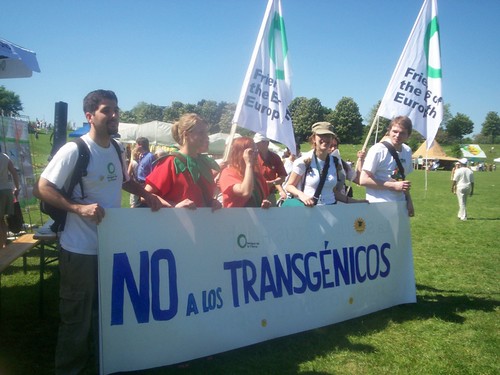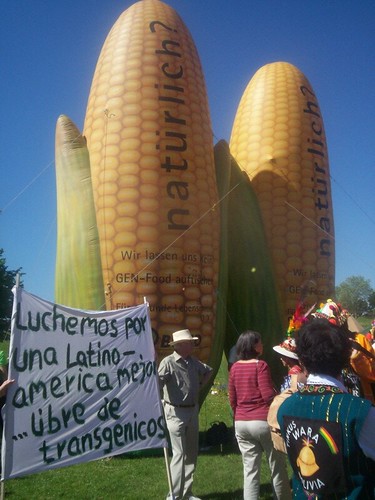Seminario sobre transgénicos en América Latina

El pasado mes de mayo el Proyecto de Bioseguridad de Puerto Rico participó de Planet Diversity (http://www.planet-diversity.org/), un congreso mundial de la sociedad civil para discutir el futuro de la agricultura y los alimentos celebrado en la ciudad alemana de Bonn. Una de las actividades fue un seminario sobre transgénicos en América Latina organizado por la Red por una América Latina Libre de Transgénicos. A continuación las conclusiones del seminario.
CONCLUSIONES DEL SEMINARIO
SITUACION DE LOS CULTIVOS TRANSGENICOS EN AMERICA LATINA
Bonn, Alemania, 14 Mayo 2008
El Seminario “Situación de los Transgénicos en América Latina” fue coordinado por la Fundación Sociedades Sustentables como parte de la Red por una América Latina Libre de Transgénicos (RALLT). Se efectúo en las dependencias de Gustav Stressmann Institute en Bonn, Alemania, el Miércoles 14 Mayo de 2008, y se realizo como un evento paralelo a las negociaciones de la Cuarta Reunión de las Partes del Protocolo de Cartagena.
El programa del seminario se cumplió cabalmente con 6 presentaciones, comenzando con un panorama general de los transgénicos en América Latina, después se presento la situación de la papa transgénica y se continuó con cuatro presentaciones sobre las situaciones nacionales en Brasil, Argentina, Paraguay y Chile. El programa fue el siguiente:
1. La situación de los transgénicos en América Latina. Elizabeth Bravo, Acción Ecológica, Ecuador. Coordinadora RALLT (la charla fue presentada por Maria Isabel Manzur en reemplazo de Elizabeth Bravo que no pudo asistir)
2.La situación de la papa transgénica en América Latina. Georgina Catacora, Tierra Viva, Bolivia.
3.La situación de los transgénicos en Argentina, Jorge Rulli, Grupo de Reflexión Rural, Argentina.
4.Impactos del cultivo de la soja en Paraguay. Gilda Roa, Movimiento Agrario Campesino, Paraguay.
5.La situación de las semillas transgénicas y cultivos farmacéuticos en Chile. María Isabel Manzur, Fundación Sociedades Sustentables, Chile.
6.La situación y la soya y el maíz transgénico en Brasil. Gabriel Fernades, ASPTA, Brasil.
El seminario contó con la participación de alrededor de 40 personas. Fue moderado por Mari Carcamo de Rapal Uruguay, el debate estuvo a cargo de María Isabel Manzur de Chile y la traducción al ingles la efectuó Carmelo Ruiz de Puerto Rico quien gentilmente nos colaboró de forma voluntaria. La lista de asistentes se adjunta en el Anexo a este documento.
Posterior a las presentaciones, el seminario finalizó con un enriquecedor debate sobre las prioridades de acción en América Latina respecto a los transgénicos y su expansión. Las propuestas efectuadas por los participantes se resumen a continuación de manera resumida.
Se mencionaron las siguientes necesidades de acción:
Diagnóstico - Monitoreo
Efectuar un diagnostico de la situación de los transgénicos en los países de América Latina.
Efectuar un diagnóstico de las estrategias de las empresas a nivel continental y un mapeo de las áreas donde están presentes las corporaciones.
Efectuar monitoreos de la contaminación accidental de semillas y la entrada ilegal de semillas transgénicas a los países. Para esto se requiere de acceso a test kits baratos y sencillos de utilizar.
Monitorear los proyectos de papas transgénicas del Centro Internacional de la Papa (CIP) en Perú.
Monitorear la expulsión de campesinos de sus tierras para aumentar la superficie de cultivos transgénicos en los países donde esta ocurriendo.
Protección de Semillas
Proteger los centros de biodiversidad y de origen en América Latina y declararlos zonas libres de transgénicos. Todas las campañas debieran incluir esta temática.
Se debiera además apoyar y mantener las zonas libres que aun existen.
Apoyar a los productores no transgénicos para mantener sus cultivos libres de transgénicos y apoyar acciones de Indemnización por contaminación.
Fomentar la conservación de las semillas tradicionales, incluir a los agricultores como conservadores de las semillas y multiplicar los bancos de semillas.
Realizar campañas a nivel local y a nivel global de forma articulada.
Dar a conocer las iniciativas en América Latina sobre conservación de biodiversidad agrícola.
Intercambio de Información
Potenciar el intercambio de información en la región. Apoyar a la Red por una América Latina Libre de Transgénicos (RALLT) como un órgano importante de difusión de información y coordinación.
Realizar un boletín mensual analítico de la situación de América Latina.
Efectuar seminarios regionales y una reunión a nivel del continente que recoja los resultados de los seminarios regionales.
Efectuar talleres regionales de las comunidades indígenas y nativas sobre conocimiento colectivo y patentamiento.
Hacer accesible la información sobre transgénicos, acceso a recursos genéticos, patentes, a las comunidades a nivel local.
Acciones Legales
Enfrentar el problema humanitario que se está generando en varios países de América Latina (expulsiones, envenenamientos por plaguicidas, crímenes, persecuciones etc), producto de la expansión de la soya transgénica. Utilizar herramientas jurídicas, como la Corte Internacional de la Haya por crímenes contra la humanidad.
Enfrentar el tema de la mayor expansión de la frontera transgénica, de las superficies de cultivos y de mas tipos de cultivos aprobados.
Utilizar leyes antitrust y redes.
Aumento de Conciencia –Trabajo en Redes
Fortalecer la educación de jóvenes de culturas originarias para conservar sus recursos.
Aumentar la conciencia y la sensibilidad en los consumidores y autoridades de países importadores de semillas o granos transgénicos sobre el alto costo que implica la producción de estos cultivos en países productores, de los impactos de vidas humanas, a la salud, socioeconómicos y a la biodiversidad.
Establecer lazos entre consumidores del norte y productores de transgénicos y la sociedad civil de países del Sur. Fortalecer el poder de los consumidores para rechazar los productos transgénicos. Establecer campañas coordinadas entre países del norte y del sur.
Utilizar redes existentes europeas o de otros países, que monitorean a las corporaciones.
Generar sistemas de activismo por Internet.
Varios
Se debe denunciar el aumento del uso de herbicida en los cultivos transgénicos y efectuar campañas contra el glifosato y sus impactos en la biodiversidad, en la creación de supermalezas , impactos en los anfibios y la salud humana. También denunciar los impactos de la toxina del maíz Bt y del glifosato en el suelo.
Cuestionar no solo los transgénicos sino el modelo de monocultivo. Las denuncias deben mostrar el modelo alternativo evitando mostrar a la soya convencional como alternativa a la soya transgénica, sino enfatizar que la verdadera alternativa es la soya agroecológica.
Se debe denunciar que la soya transgénica sustentable es una solución falsa.
Se debe aclarar que la soya transgénica no es una solución al cambio climático pues es más susceptible por su homogeneidad genética.
SE debe promover la agricultura agroecológica como alternativa al modelo de monocultivos y transgénicos, capacitar a lideres campesinos en agroecología y sistematizar las experiencias. La conservación de semillas debe hacerse bajo un modelo agroecológico y se debe masificar la información sobre agroecología.
Es indispensable promover el control de las semillas y el control de la tierra. Se debe evitar la perdida de territorio y asegurar el acceso a tierra y semilla que permita una soberanía territorial, cultural y alimentaria.
Se debe estar atento que la expansión de los agrocombustibles en América Latina que propicia la expansión de los transgénicos.
Es indispensable buscar apoyo financiero a las campañas contra los transgénicos en América Latina.
Detener la producción de semillas transgénicas y cultivos farmacéuticos en América Latina.


